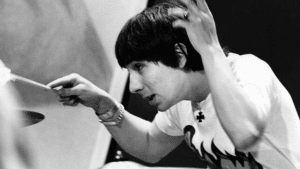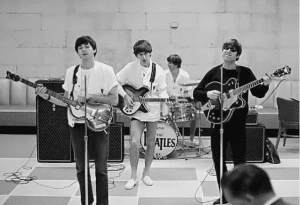The Underrated Beatles Songs Released From 1966 to 1970

via @_with_the_beatles_ | Instagram
By 1966, the immense pressures of fame began taking a toll on the Beatles. Their relentless touring schedule and the grueling pace of releasing singles and albums had pushed them to their limits. That year marked a turning point as they decided to step away from live performances and focus on their personal and artistic growth.
This shift gave the Beatles the freedom to redefine what rock music could be. With unlimited studio time and a willingness to explore uncharted musical territory, they embarked on a period of remarkable experimentation. Despite their innovative streak, the band stayed true to their lyrical roots and maintained a level of quality that few could match.
While many of their songs became iconic, some of their finest tracks from 1966 to 1970 remain overlooked. These underrated gems showcase the Beatles’ creativity and depth during a transformative era in their career.
https://twitter.com/b1lly_shears/status/1869443873921257575
“One After 909” – Let it Be (1970)
“One After 909” stands as one of the earliest collaborations between John Lennon and Paul McCartney. Though a version was recorded in 1963, it was lost to time. In 1970, the band decided to revive the track, reconnecting with their roots during a pivotal moment in their career.
The song’s simplicity is its charm—a train blues piece that exudes a raw, unpolished energy. Lennon and McCartney deliver the vocals with undeniable chemistry, capturing the youthful spirit of their early songwriting days.
George Harrison’s guitar work adds a dynamic edge to the track. Performed during their legendary rooftop concert, “One After 909” serves as a nostalgic nod to where it all began for the Beatles.
Polythene Pam – Abbey Road (1969)
Despite their global fame, the Beatles often wove pieces of their Liverpool roots into their music. Tracks like “Penny Lane” and “I Am the Walrus” are filled with references to local jokes and memories from their school days in Merseyside.
“Polythene Pam,” featured in the medley on Abbey Road, is another nod to their origins. John Lennon’s vocal delivery stands out as he leans into his Scouse accent, particularly during the second verse. It’s a playful reminder of where it all began for the band.
The song’s placement within the medley adds to its charm, blending humor and nostalgia into the album’s grand finale. It’s a brief but memorable moment that showcases Lennon’s ability to bring a piece of Liverpool to a global audience.
“Lovely Rita” – Sgt. Pepper’s Lonely Hearts Club Band (1967)
It’s rare to label any track from Sgt. Pepper’s Lonely Hearts Club Band as overlooked, but “Lovely Rita” often finds itself unfairly dismissed. Critics sometimes brush it off as lightweight McCartney filler, missing the deeper charm within the song.
Beneath its upbeat melody lies a showcase of McCartney’s vocal prowess. His performance is confident and effortless, embodying a playful indifference toward his unrequited feelings for Rita. In typical McCartney fashion, he shrugs it off with style.
The song’s whimsy is part of its magic, blending humor with impeccable craftsmanship. “Lovely Rita” may not steal the spotlight, but it proves that even McCartney’s “filler” tracks can be captivating.
“Rain” – B-Side to “Paperback Writer” (1966)
Ringo Starr often faced unfair critiques as a drummer, but Rain, the B-side to “Paperback Writer,” stands as a powerful rebuttal. His performance on this track is arguably one of his finest, rivaling even his celebrated drumming on “A Day in the Life.”
The track highlights Starr’s creativity and precision, with fills that elevate the song’s psychedelic vibe. For those who doubt his skill, playing “Rain” serves as a compelling argument for his brilliance behind the kit.
Adding to its uniqueness, the recording was slowed down, giving the drums an even more dynamic, thunderous feel. It’s a testament to how Ringo’s contributions shaped the Beatles’ innovative sound.
“Two of Us” – Let it Be (1970)
The Let it Be sessions were fraught with tension as the Beatles faced the end of their journey together. Amid the chaos, Paul McCartney emerged as the driving force behind the project, crafting some of its most memorable tracks.
“Two of Us” is a rare and touching moment from this turbulent time. Like “One After 909,” it captures John Lennon and McCartney setting aside their differences to create something beautiful. Their harmonies reflect the bond they shared, even as the band unraveled.
Interestingly, Lennon believed the song was about his friendship with McCartney, though it was written for Linda Eastman, McCartney’s future wife. This duality adds a layer of poignancy, making “Two of Us” a heartfelt highlight of the album.
“I’m So Tired” – The Beatles (1968)
The White Album is a treasure trove of deep cuts, and “I’m So Tired” is one of its standout gems. While the album lacked traditional singles, it showcased the Beatles’ ability to experiment and push boundaries, as only they could.
John Lennon’s performance on this track is captivating, blending exhaustion with raw emotion. The verses capture a languid, almost defeated tone, while the middle section bursts with a fiery intensity that reveals his inner turmoil.
Lennon’s vocal delivery and lyrical honesty make “I’m So Tired” a strikingly personal moment on the sprawling album. It’s a song that lingers, pulling listeners into the depths of his emotional exhaustion.
“For No One” – Revolver (1966)
“For No One” stands apart from typical breakup songs, exploring a more complex emotion—the quiet, inevitable end of a relationship. Paul McCartney captures the moment when communication fades, and all that remains are memories of what once was.
The song is a beautiful yet melancholic depiction of love lost, with McCartney’s melody wrapping the painful lyrics in a soothing embrace. It’s a quiet moment of reflection, where the beauty of the music contrasts with the sadness in the story.
Adding to its poignancy, McCartney introduces a French horn solo, an unusual choice in rock. This delicate touch further softens the heartbreak, making “For No One” a timeless example of the Beatles’ emotional depth and musical innovation.
“Mother Nature’s Son” – The Beatles (1968)
“Mother Nature’s Son” is one of McCartney’s most delicate and beautiful compositions. Released in 1968 on The White Album, it marks a peak in his exploration of folk music. The song’s simplicity and elegance stand out, offering a stark contrast to much of the album’s experimental nature.
What’s remarkable is how this soft, acoustic ballad fits seamlessly between two intense Lennon rockers. It’s a testament to McCartney’s ability to shine in any musical landscape, even when surrounded by louder, more chaotic tracks like “Yer Blues” and “Everybody’s Got Something to Hide Except for Me and My Monkey.”
The song’s gentle melody and heartfelt lyrics create a peaceful oasis within the album. “Mother Nature’s Son” is a shining example of McCartney’s craftsmanship during one of the Beatles’ most adventurous periods.
“Getting Better” – Sgt. Pepper’s Lonely Hearts Club Band (1967)
“Getting Better” is a fascinating example of the tension between John Lennon and Paul McCartney’s musical personalities. Although they often worked separately, their songs were still credited to both, with each bringing their own flavor to the collaboration.
On this track, Paul’s unwavering optimism shines through with the hopeful line, “It’s getting better all the time.” Yet, John’s sharp sarcasm cuts through, countering with “It can’t get no worse,” highlighting their contrasting worldviews.
This song is one of the last true Lennon-McCartney collaborations, a reflection of their creative partnership nearing its end. The interplay between Paul’s positivity and John’s cynicism makes “Getting Better” a standout moment on Sgt. Pepper’s, encapsulating the complexities of their relationship.
“Hey Bulldog” – Yellow Submarine (1968)
“Hey Bulldog” stands out for John Lennon’s scorching vocal performance, delivering even the most absurd lyrics with intense emotion. Much like “I Am the Walrus,” this track draws inspiration from the nonsensical writings of Lewis Carroll, yet Lennon’s delivery makes the absurd feel meaningful.
The song’s energy is driven by an unforgettable riff, played simultaneously on the piano, guitar, and bass. The interplay of these instruments creates a powerful sonic foundation, amplified by Ringo Starr’s dynamic drumming.
“Hey Bulldog” is a hidden gem from the Yellow Submarine soundtrack, where the raw energy and unique riff elevate the song beyond its whimsical roots. It’s a perfect example of how Lennon’s vocal intensity could bring life to even the most playful of ideas.





















